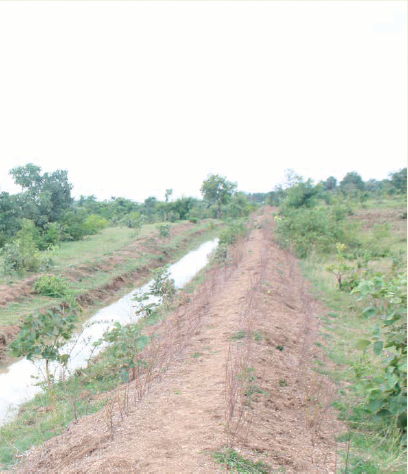Bracing for Tough Times through Smart Work

Introduction
Banjhimunda village is located in Kantamal block of Boudh District in Odisha. The village experiences frequent droughts and acute drinking water shortage due to its location and untimely rainfall for at least 4–6 months in a year. Frequent droughts forced people to either migrate to other places for employment or depend on forest for livelihoods. The average annual rainfall in the district is 1,510 mm but most of the rainwater received during monsoon drains away damaging agricultural fields and the main road, and it remains dry during the rest of the year. This necessitates building structures that can effectively prevent the flow of rainwater downstream, which causes a lot of inconveniences. Hence, the line department (Integrated Watershed Management Programme) drew up a detailed plan to construct three big check dams (one check dam under MGNREGS and two check dams under IWMP) and a series of tanks/ponds inside the catchment areas of the check dams for protecting and promoting livelihoods of the people.

Implementation
The water harvesting project was approved under MGNREGA in the financial year 2017–2018. An expenditure of Rs. 7.84 lakhs (Rs. 5.83 lakhs for wages and Rs. 2.01 lakhs for material) was incurred
on construction of one check dam under MGNREGS. IWMP constructed two more check dams beside the one constructed under MGNREGS under the convergence scheme. The technical team worked hand in hand with the villagers for the construction of three check dams with additional tanks and ponds.

Impact
The rainwater that previously drained off is now being stored for irrigation and domestic use throughout the year (Table 1). During the summer season, Banjhimunda village has abundant water for domestic use. Soil erosion was checked, and the moisture content of the soil has also gone up. Crop production has been increased threefold from the same measure of land. The villagers have successfully moved from cultivating a single (paddy) crop to multiple crops such as pulses and vegetables. Additionally, Fisheries and Animal Resources Development Departments, Government of Odisha in convergence with MGNREGS helped the farmers to increase their revenue from pisciculture.

Table 1: Socio-economic impact of Water Harvesting Structure under MGNREGA in Banjhimunda Village, Baragochha GP:

Voice
“After the construction of these check dams, we are really happy. During summer, we get water and in monsoon, we are not affected by floods anymore. Earlier, I used to get 5 quintals of paddy/year
from my 2 acres of land. Now from the same measure of land, I am harvesting 15 quintals of paddy/year”. —Shri Anadi Singha, villager
“After constructing these check dams, we are really happy because we get water throughout the year. The water level in our wells has come up by at least 3 ft. Earlier, I used to produce 5 quintals/acre, but now am able to reap 15 quintals/acre”. —Shri Biswakesami Singh, farmer





